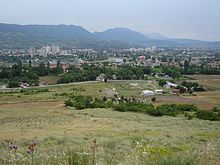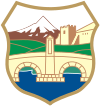Scupi
 Panorama of Scupi and Skopje. | |
| Location | Skopje |
|---|---|
| Coordinates | 42°00.996′N 21°23.524′E / 42.016600°N 21.392067°E |
Scupi (
History

Scupi became the capital of
The moving of the city is often connected with the founding of
He therefore built a wall of small compass about this place in the form of a square, placing a tower at each corner, and caused it to be called, as it actually is, Tetrapyrgia. And close by this place he built a very notable city which he named Justiniana Prima, thus paying a debt of gratitude to the home that fostered him. In that place also he constructed an aqueduct and so caused the city to be abundantly supplied with ever-running water. And many other enterprises were carried out by the founder of this city - works of great size and worthy of especial note. For to enumerate the churches is not easy, and it is impossible to tell in words of the lodgings for magistrates, the great stoas, the fine marketplaces, the fountains, the streets, the baths, the shops. In brief, the city is both great and populous and blessed in every way.
— Procopius, description of Justiniana Prima in 'The Buildings'
Excavations

The excavations on the archaeological site started in the period between the two World Wars. Radoslav Gruić discovered the early Christian basilica in 1925 and the most important discovery was made by Nikola Vulić, a Serbian archeologist, when he found the ancient Macedonian theater. Nikola Vulić was the archeologist that published most about Scupi.
Excavations on the site were done in 1959–61 by Duje Rendić-Miočević that were published in 1981 and by Ivan Mikulčić published in 1971 and 1973.
The Museum of the City of Skopje began new excavation and conservation work on the site from 1966 led by Milutin Garašanin. From 1980 the person responsible for the excavation and conservation work on the site is Dušanka Koraćević.
In July 2008, a well-preserved statue of the Roman goddess
The Illyrian tribe Albanoi is attested in an ancient funeral inscription in Scupi[7] It was excavated in 1931 by Nikola Vulić and its text was curated and published in 1982 by Borka Dragojević-Josifovska. The inscription in Latin reads "POSIS MESTYLU F[ILIUS] FL[AVIA] DELVS MVCATI F[ILIA] DOM[O] ALBANOP[OLI] IPSA DELVS" ("Posis Mestylu, son of Flavia, daughter of Delus Mucati, who comes from Albanopolis"). It dates to the end of the 1st century CE and the beginning of the 2nd century CE. Dragojević-Josifovska added two lines to the existing reading: VIVA P(OSUIT) SIBI/ ET VIRO SUO. Dragojević-Josifovska proposed that like others he had settled in Macedonia from southern Illyria.[8]
Buildings

There are four building periods. The first is the time of the alleged camp of two legions from 168 BC. The second is the foundation of the Roman colonia that ended with the invasion by the Goths in AD 269. The third period is most distinguished and is represented by the remains of one civil basilica, a complex of baths (thermae) and one townhouse. The last, the fourth period that begins roughly after the invasion by the Ostrogoths from AD 472 or 489 is represented by remains of an early Christian basilica and a townhouse with apse. Scupi was completely destroyed in AD 518.
Today, only the early Christian basilica, the civil basilica, the baths and townhouses along the road are recognizable. The Roman theatre is completely decayed.
Roman theatre
The theater is estimated to have been built in the 2nd century AD because of the signs Colonia Scupi Aelia on the seats. It is assumed that the theater was built for Hadrian, the Roman emperor, who was visiting the Balkan cities. The decoration of the Roman theater was on the highest level, comparable to the best in the world from that time. Ivan Mikulčić writes that in the 1000 years of the ancient period, there is no building that has reached the refined level of art as in the Roman theater in Scupi.
Nikola Vulić claims that the theater in Scupi is larger than the one in Stobi, and Duje Rendić-Miočević claim that is the largest on the territory of modern North Macedonia.
The theater was used only for theater performances, comedies and tragedies. There is no architectural proof that the theater was used for gladiator games as it is the case in the theater in Stobi.
See also
- Tabula Peutingeriana (image; Scupi marked as a city on the Peutinger table)
- Stobi
- Heraclea Lyncestis
- Nikola Vulić
References
- ^ Macedonia yesterday and today Author Giorgio Nurigiani, Publisher Teleurope, 1967 p. 77.
- ^ Vladimir P. Petrović, Pre-Roman and Roman Dardania Historical and Geographical Considerations, Balcanica XXXVII, p 10.
- ^ The Cambridge Ancient History, John Boardman, Volume 13 of The Cambridge Ancient History, Author Averil Cameron, Contributor R. C. Blockley, Publisher Cambridge University Press, 1996, p. 570.
- ISBN 0-631-19807-5, p. 213.
- ^ 42°01′00″N 21°23′31″E / 42.0166°N 21.3920733°E.
- ^ Balkan Travellers Archived 2012-02-09 at the Wayback Machine
- ^ Dragojević-Josifovska 1982, p. 32
- ^ Dragojević-Josifovska 1982, p. 32
Sources
- Koraćević, Dušanka (2002) Scupi. Skopje: Museum of the city of Skopje
- Procopius. (1940). The Buildings, Book IV (Part 1). Retrieved from the website.
42°00.996′N 021°23.524′E / 42.016600°N 21.392067°E


